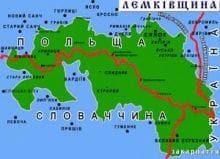History of Lemkivshchyna
The southern Lemko region belonged to Kyiv’s sphere of influence from the mid-10th century to the 1020s, when it came under the rule of Hungary . The eastern part of the northern Lemko region, extending to the Wisloka River , belonged to Kyivan Rus’, and then the Principality of Galicia-Volhynia. After Casimir III the Great occupied the eastern part of the Lemko region in the 1340s, the entire Lemko region came under the rule of Poland until 1772. The eastern part formed the so-called Sianik land, which was part of Ruthenia voivodeship; the western part was integrated into Cracow voivodeship.
From the mid-14th century, three colonization waves penetrated the Lemko region: Slovak-German colonists from the southwest, who settled in Transcarpathia; German-Polish colonists from the northwest; and Ukrainians, with Wallachian herdsmen, who settled in the east. The non-Ukrainian colonists occupied the lower, agricultural zone of the foothills and denationalized most of the Ukrainian inhabitants, particularly those between the Wisloka River and Sian River . The Ukrainian settlers occupied the sparsely-populated, wooded Beskid Mountains . Their villages were usually founded on Wallachian law, and they engaged in animal husbandry. In the western Lemko region, which never belonged to Galicia-Volhynia, the Ukrainian colonists wedged themselves in between the Poles and the Slovaks, although some scholars claim that they overpowered a scanty Polish population that had lived there for a long time. Colonization ended in the 16th century, although some new settlements sprang up in the 17th century. By the end of the 16th century, the contemporary Lemko dialects had been formed and the dialects’ boundaries, which with minor changes lasted until 1946, had been established.
Source: Encyclopedia of Ukraine, Shevchenko Scientific Society





